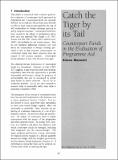| dc.contributor.author | Maxwell, Simon | en |
| dc.date.accessioned | 2016-02-24T15:50:50Z | |
| dc.date.available | 2016-02-24T15:50:50Z | |
| dc.date.issued | 01/10/1996 | en |
| dc.identifier.citation | Maxwell, S. (1996) Catch the Tiger by its Tail: . IDS Bulletin 27(4): 35-48 | en |
| dc.identifier.issn | 1759-5436 | en |
| dc.identifier.uri | https://opendocs.ids.ac.uk/opendocs/handle/20.500.12413/9225 | |
| dc.description.abstract | Summaries Counterpart funds generated by programme aid do not provide real resources over and above the commodities or foreign exchange transferred as aid: they represent the tail not the tiger. However, donor policy has evolved to recognise this fact and now focuses less on specific ear?marking of counterpart funds, more on the overall quality of the budget process. This development opens up new and more interesting possibilities for evaluating the effectiveness and efficiency of counterpart fund management. The paper proposes performance criteria, especially for bilateral donors supporting the budget through counterpart fund generation. Existing evaluations do not generally provide information about whether these standards have been satisfied. This is a task for the future. | en |
| dc.format.extent | 14 | en |
| dc.publisher | Institute of Development Studies | en |
| dc.relation.ispartofseries | IDS Bulletin Vol. 27 Nos. 4 | en |
| dc.rights.uri | http://www.ids.ac.uk/files/dmfile/IDSOpenDocsStandardTermsOfUse.pdf | en |
| dc.title | Catch the Tiger by its Tail: | en |
| dc.type | Article | en |
| dc.rights.holder | © 1996 Institue of Development Studies | en |
| dc.identifier.doi | 10.1111/j.1759-5436.1996.mp27004004.x | en |

